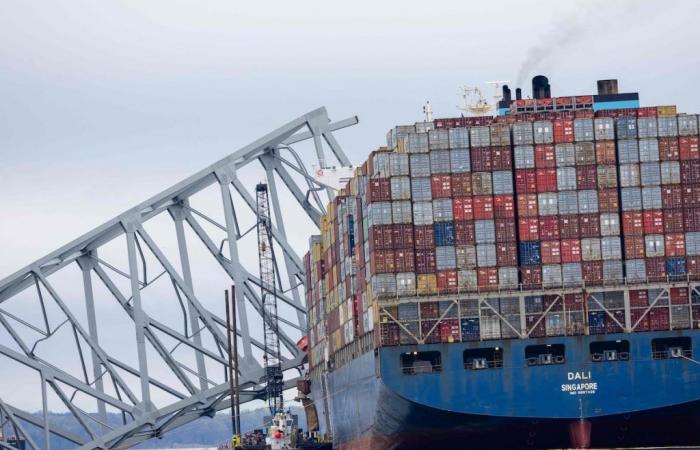Even from miles away, the destruction of the Francis Scott Key Bridge, in Baltimoreus U.S, it’s a shocking visual: chunks of steel jut out over the water like metal icebergs. Twisted gray beams are seen in door positions. From a park near Fort McHenry, visitors can see the giant freighter that crashed into the bridge and remained trapped in the rubble.
Less visible, however, are the 22 crew members from India who have remained on the ship, called Dali, since the disaster on March 26.
Little is known about them other than that they are sailors who embarked on a journey on the 985-foot-long ship that was on its way to the Sri Lankacarrying 4,700 containers, when it lost its power and crashed into the bridgecausing the collapse of its structure.
continues after advertising
Since the accident, that killed 6 construction workers, the crew found themselves in an unexpected spotlight. While keeping the ship operable, they are answering a series of questions asked by officers investigating the catastrophe, while evidence of what occurred lies all around them in mangled ruins that stretch across the bow and deck.
continues after advertising
As officials investigate what may have caused the tragedy, another question came to light this week: What could crew members, who have limited access to the outside world, be experiencing at this time?
“They should feel the weight of responsibility for not being able to stop this from happening,” said Joshua Messick, executive director of the Baltimore International Seafarers’ Center , a religious nonprofit that seeks to protect seafarers’ rights.
Even so, authorities praised the crew’s quick distress message, transmitted over the radio when the ship lost. Before the Dali hit the bridge, the distress call helped officers stop traffic and prevent more cars from entering the bridge, likely saving many lives, authorities said.
continues after advertising
While the ship remains stuck in the Port of Baltimore, where it is expected to remain for weeks, the lives of the crew have entered an uncertain phase. But one thing remains guaranteed: they will no longer cross the sea around the South Africa heading towards your destination in Sri Lanka anytime soon.
But they also won’t be docking at the port imminently, as they must wait for enough debris to be removed to free the ship and reopen the canal to one of the busiest ports in the United States. On Saturday, the governor of Maryland said that authorities planned to remove the first piece of debris.
continues after advertising
Deadline for removing the wreckage?
So to date, crew members are practically working a grueling schedule to maintain the ship, similar to what they would do if they were at sea. The difference, however, is that they sit still while the eyes of the world are fixed on them, experts say.
“The ship’s captain and crew have duties to the ship,” said Stephen Frailey, a partner at Pacific Maritime Group, which helps with marine salvage and wreck removal.
continues after advertising
According to Chris James, who works for a consultancy firm that helps manage the ship, Synergy Marine, the crew have ample supplies of food and water, as well as plenty of fuel to keep the generators running. In fact, when Jennifer Homendy, president of the National Transportation Safety Board, boarded the ship this week, she watched the cook making food. “It smelled really good,” she said.
But there is still no exact timeframe for when the ship can be removed from the wreckage, James said. Once the National Transportation Safety Board and the Coast Guard finish their investigations, he said, “we will look at the possibility of changing the crew and allowing them to return home.”
Photograph: Kaitlin Newman/The Baltimore Banner via AP
continues after advertising
“We may lose jobs”
Indiathe crew’s home country, is one of the world’s largest hubs for mariners, according to John A. Konrad, a sea captain and chief executive of the gCaptain, a maritime and offshore industry news website. Although Indian captains and engineers are paid less than Americans in the same role, Konrad said, they make a decent living when they work three or more months a year at sea.
Working on a cargo ship, he said, is a 24-hour job with no weekends off. Every day, decks are checked for maintenance and safety, cooks and cleaners tend to other members, and workers in the engine room keep things on track.
However, cargo ship crews have some leisure activities available on board, such as video game breaks in cabins, gym workouts, ping pong sessions and movie nights. The Dali’s crew has at least one TV, magazines and books on board, said Andrew Middleton, who runs Apostleship of the Sea, a program that ministers to sailors passing through the port.
Clistan Joy Sequeira, an Indian sailor who was not on the Dali but who docked in Baltimore with another cargo ship on Friday the 29th, said in an interview that he feared the repercussions the bridge collapse could have on the industry and the your country. “I’m afraid that, because the team is Indian, our international image will be harmed,” said Sequeira, 31 years old. “We might lose jobs.”
Some members of the Baltimore port community had some contact with Dali’s crew, albeit brief, through third parties or WhatsApp. Messick said he sent the crew two Wi-Fi hotspots on Friday because they did not have internet on board.
Middleton, from the Apostolate of the Sea, said he was in contact with two crew members, reminding them that “we are here to help you”. “When I asked how they were doing, the answers ranged from ‘fine’ to ‘great,’” he says. “So, by their own accounts, they are fine.”
Messick said he also sent a care package to the crew through a salvage company that is helping with operations. The packages included sweets, homemade muffins sent by a concerned resident and letters of thanks written by children.
With so many unanswered questions about the crew’s next steps, Messick said he is eager to provide them with trauma care and emotional support. On Friday he wrote a letter to the captain, which was delivered by another ship. “We are here to support you,” he said.
Tags: Indian sailors remain ship crashed Baltimore bridge week accident
--





